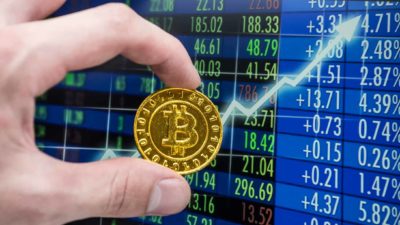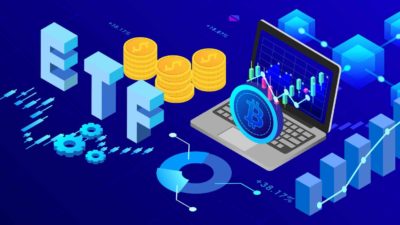It's been just over a month since investors woke up to a brand new, crypto-themed exchange-traded fund (ETF) trading on the Australian markets.
The Cosmos Global Digital Miners Access ETF (DIGA) commenced trading on the ASIC-regulated Aussie exchange Chi-X on 28 October. (You can find our coverage following its first day of trading here.)
Now DIGA doesn't invest directly into Bitcoin (CRYPTO: BTC), Ethereum (CRYPTO: ETH), or any of the other range of altcoins with growth potential. No Australian-listed ETFs have been given the green light by regulators to do so yet.
Instead, DIGA gives investors exposure to the crypto world via a basket of cryptocurrency mining and infrastructure companies.
With DIGA now entering its second month of trading, the Motley Fool reached out to Dan Annan, CEO of Cosmos Asset Management, for his insights into this rapidly evolving market.
Below you'll find part 1 of that interview.
Motley Fool: What was the market's reaction to DIGA in its first week of trading?
Dan Annan: The feedback from DIGA's debut was very positive. The market was impressed with the product design, in that the fund focused on the ETF benefits of liquidity, diversification, and access to the crypto asset class without diluting the cryptocurrency asset class exposure.
Cosmos designed a robust product to give investors the closest exposure to the digital currency asset class without sacrificing liquidity. And it was exciting for the team to see the market reception and intrigue in DIGA.
The objective of DIGA is to track the Global Digital Miners Index. The index is designed to provide access to the picks and shovels of companies listed globally on national stock exchanges, with the primary business focused on crypto mining and infrastructure.
MF: What do you see driving the increased demand and broader institutional adoption of cryptos like Bitcoin?
DA: One of the great mysteries of modern life is the time it still takes for international money transfers to clear and settle. Every other aspect of our lives is increasingly digital, reduced to a tap of your phone or the press of a key. But money transfers take days to rumble from the payee to the original bank. That's days of lost opportunity and plenty of fees for the intermediaries passing them around behind the scenes.
Bitcoin and crypto more broadly has been the breakthrough. And it has only started getting institutional support globally since last year. Bitcoin allows for a true digital store of value and transfer. Transactions can be done natively digital in a way that is fast, limitless, secure, and transparent.
MF: How has DIGA performed since launching on 28 October?
DA: From a timing perspective, Bitcoin rallied right around the launch of DIGA on 28 October, which by its design brings a 0.75 correlation to Bitcoin. So we saw DIGA break records for its first 5-day performance debut over all ETFs to list in the Australian market over the past 5 years, delivering 25% returns.
That 25% return is measured by the fund's NAV [net asset value], with the opening NAV at 4.9977 on 28 October and a closing NAV of 6.2454 on 5 of November. This performance broke the record for all ETFs to debut in the Australian market over the past 5 years.
MF: What kind of volatility can investors expect in a crypto ETF like DIGA?
DA: The objective of DIGA is to deliver access to the outsized returns we are seeing in the crypto asset class. That said, investors should have a long-term view to withstand the daily volatility this asset class presents.
Month-to-date, as at 25 November, DIGA is among the top-performing ETFs in the Australian market. It's delivered more than a 20% return since inception [as at 25 November] as measured by NAV, with an opening NAV of 4.9977 on 28 October and a closing NAV of 6.1561 on 25 November.
MF: Why did you opt for a Chi-X listing?
DA: What many investors aren't aware of is that both exchanges, the ASX and Chi-X, are top tier 1 licensed stocked exchanges. Chi-X is owned by Chicago Options Board Exchange, which is the largest ETF listing venue in the US.
Chi-X, for example, makes up about 20% of equity trading and more than 35% of fund trading in Australia. The fact is, if you've bought a BHP share or units in STW in the last 10 years, you've probably already traded on Chi-X and didn't realise it.
With that said, we liked the innovation Chi-X brings to the table to work with start-ups like Cosmos, and we took the opportunity to work with them on DIGA. We liked the prospect of working with a platform that was open to our innovative ideas in the crypto asset class.
MF: What criteria do you look for in crypto mining and infrastructure companies before adding them, removing them, or adjusting their weighting within the ETF?
DA: The index methodology for the Global Digital Miners Index (GDMI) is clean and clear with transparent rules to consider.
These include:
- Companies listed on global national exchanges;
- Companies with a minimum market cap of US$100 million;
- Companies that generate at least 80% of their revenue from crypto mining and infrastructure; and
- Companies with median daily trading volume exceeding than US$1 million.
The index follows a free-float adjusted market capitalisation weighted methodology, and it's rebalanced on a monthly basis. For diversification purposes, no single stock may have a weight greater than 15% as of the rebalance date.
DIGA's objective is to replicate the Global Digital Miners Index, and we are very proud of how the team has been tracking the index thus far.
**
(Tune in tomorrow for part 2 of our interview with Dan Annan. You can find out more about DIGA here.)









